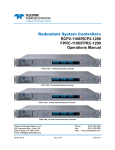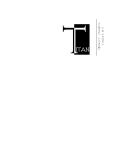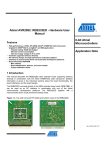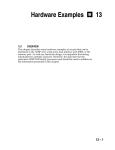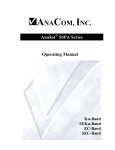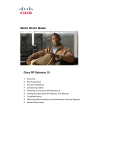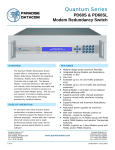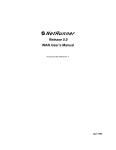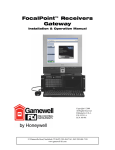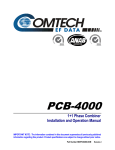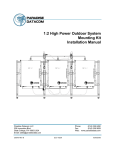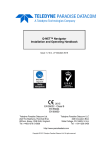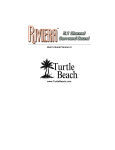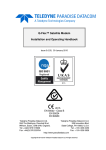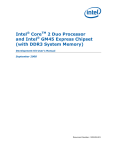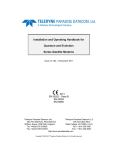Download Paradise RCP2-1000 User's Manual
Transcript
Operations Manual RCP2-1000 Remote Controller for Rack Mount SSPAs PARADISE DATACOM RCP2-1000 SSPA REMOTE CONTROLLER Paradise Datacom LLC 328 Innovation Blvd. State College, PA 16803 USA Email: [email protected] 203987 Rev A Phone: (814) 238-3450 Fax: (814) 238-3829 Web: www.paradisedata.com ECO 3171 11/28/2005 PROPRIETARY NOTICE Paradise Datacom has made every effort to ensure that the instructions contained in this document are adequate and free of errors and omissions. Paradise Datacom will, if necessary, explain issues, which may not be covered by this document. Paradise Datacom’s liability for any errors in this document is limited to the correction of errors and the aforementioned advisory services. This document has been prepared to be used by professional and properly trained personnel, and the customer assumes full responsibility when using this document. Paradise Datacom welcomes customer comments as part of the process of continual development and improvement of the documentation in the best way possible from the user’s viewpoint. Please submit your comments to your Paradise Datacom sales representative at the following address: 328 Innovation Blvd. State College, PA 16803 USA Telephone: 814-238-3450 Fax: 814-238-3829 E-mail: [email protected] To allow for the introduction of design improvements, specifications are subject to change without notice. © 2005 Paradise Datacom LLC Printed in the USA 2 203987 Rev A RCP2-1000 RM Remote Controller Operations Manual Table of Contents Table of Contents ........................................................................................................ 3 Section 1: General Information .................................................................................. 7 1.0 Introduction ................................................................................................... 7 1.1 Description.................................................................................................... 7 1.2 Equipment Supplied...................................................................................... 8 1.3 Safety Considerations................................................................................... 8 1.3.1 High Voltage Hazards................................................................................ 8 1.3.2 Electrical Discharge Hazards..................................................................... 9 1.4 Specification Summary ................................................................................. 9 Section 2: Installation ............................................................................................... 11 2.0 Introduction ................................................................................................. 11 2.1 Inspection ................................................................................................... 11 2.2 Mounting..................................................................................................... 11 2.3 Storage and Shipment ................................................................................ 11 2.4 Prime Power Connection ............................................................................ 11 2.5 Cable Connectors ....................................................................................... 12 2.5.1 Serial Port, Main (J4) ............................................................................... 14 2.5.2 Serial Port, Local (J5) .............................................................................. 15 2.5.3 Program Port (J6) .................................................................................... 15 2.5.4 Parallel I/O Connector (J7) ...................................................................... 15 Section 3: RCP2-1000 RM Front Panel Operation .................................................. 17 3.0 Introduction ................................................................................................. 17 3.1 RCP2-1000 RM Front Panel Description .................................................... 17 3.1.1 System Identification................................................................................ 17 3.1.2 Fault Indicators ........................................................................................ 17 3.1.3 SSPA Online Indicator ............................................................................. 17 3.1.4 Liquid Crystal Display .............................................................................. 18 3.1.5 Main Menu Key........................................................................................ 18 3.1.6 Local / Remote Key ................................................................................. 18 3.1.7 Mute / Unmute Key .................................................................................. 18 3.1.8 Navigation Keys....................................................................................... 18 3.1.9 Enter Key ................................................................................................. 18 3.2 Main Menu .................................................................................................. 19 3.2.1 Sys Info.................................................................................................... 20 3.2.1.1 Sys Info Page 1 .................................................................................... 20 3.2.1.2 Sys Info Page 2 .................................................................................... 21 3.2.1.3 Sys Info Page 3 .................................................................................... 21 3.2.1.4 Sys Info Page 4 .................................................................................... 21 3.2.1.5 Sys Info Page 5 .................................................................................... 22 RCP2-1000 RM Remote Controller Operations Manual 203987 Rev A 3 3.2.1.6 Sys Info Page 6 .................................................................................... 22 3.2.1.7 Sys Info Page 7 .................................................................................... 22 3.2.1.8 Sys Info Page 8 .................................................................................... 22 3.2.2 Panel Communication Setup Sub-Menu.................................................. 23 3.2.2.1 Protocol................................................................................................. 23 3.2.2.2 Baud Rate............................................................................................. 23 3.2.2.3 System Address.................................................................................... 23 3.2.2.4 Interface................................................................................................ 23 3.2.3 SSPA Setup Sub-Menu ........................................................................... 23 3.2.3.1 Attenuation............................................................................................ 23 3.2.3.2 Mute...................................................................................................... 23 3.2.3.3 Redundancy.......................................................................................... 24 3.2.3.4 Mode..................................................................................................... 24 3.2.3.5 SSPA ID................................................................................................ 24 3.2.3.6 Fault Setup ........................................................................................... 24 3.2.4 Panel Setup Sub-Menu............................................................................ 24 3.2.4.1 Buzzer .................................................................................................. 24 3.2.4.2 Fault Latch ............................................................................................ 25 3.2.4.3 Control Mode ........................................................................................ 25 3.2.4.4 Panel ID ................................................................................................ 25 3.2.5 Options Sub-Menu................................................................................... 25 3.2.5.1 Backup User Settings ........................................................................... 25 3.2.5.2 Restore ................................................................................................. 25 3.2.5.3 Lamp Test............................................................................................. 25 3.2.5.4 Password .............................................................................................. 25 3.2.5.5 Reset .................................................................................................... 25 Section 4: Theory of Operation ................................................................................ 27 4.0 Introduction ................................................................................................. 27 4.1 Fault Analysis and Condition Tracking........................................................ 27 4.1.1 Summary Fault ........................................................................................ 27 4.1.2 Power Supply Fault.................................................................................. 27 4.1.3 Voltage Regulator Output Low Fault........................................................ 28 4.1.4 High Temperature Fault ........................................................................... 28 4.1.5 Low DC Current Fault .............................................................................. 28 4.1.6 Low Forward RF Fault ............................................................................. 28 4.1.7 BUC Fault ................................................................................................ 28 4.1.8 Auxiliary Fault .......................................................................................... 28 4.1.9 RF Switch Fault ....................................................................................... 29 4.1.10 Serial Connection Fault ......................................................................... 29 4.2 Design Philosophy ...................................................................................... 29 4.2.1 Digital Core Board ................................................................................... 30 4.2.2 I/O Board Assembly................................................................................. 30 4.2.3 Liquid Crystal Display .............................................................................. 31 4.2.4 Front Panel Membrane Keypad ............................................................... 31 4 203987 Rev A RCP2-1000 RM Remote Controller Operations Manual Section 5: Serial Protocol ......................................................................................... 33 5.0 Introduction ................................................................................................. 33 5.1 Remote Control - Serial Communication .................................................... 34 5.1.1 Header Packet ......................................................................................... 34 5.1.1.1 Frame Sync Word................................................................................. 34 5.1.1.2 Destination Address.............................................................................. 34 5.1.1.3 Source Address .................................................................................... 34 5.1.2 Data Packet ............................................................................................. 35 5.1.2.1 Protocol ID ............................................................................................ 35 5.1.2.2 Request ID............................................................................................ 35 5.1.2.3 Command ............................................................................................. 35 5.1.2.4 Data Tag ............................................................................................... 36 5.1.2.5 Error Status / Data Address .................................................................. 36 5.1.2.6 Data Length .......................................................................................... 37 5.1.2.7 Data Field ............................................................................................. 37 5.1.3 Trailer Packet........................................................................................... 37 5.1.3.1 Frame Check ........................................................................................ 38 5.1.4 Timing Issues........................................................................................... 38 Section 6: Terminal Mode ......................................................................................... 39 Appendix A Specifications ...................................................................................... 43 RCP2-1000 RM Remote Controller Operations Manual 203987 Rev A 5 Figures Figure 1-1: Outline Drawing of RCP2-1000 RM ................................................. 7 Figure 2-1: RCP2-1000 RM Rear Panel ........................................................... 12 Figure 2-2: Cable Connections for RCP2-1000 RM ......................................... 12 Figure 2-3: Top Level Wiring Diagram .............................................................. 13 Figure 3-1: RCP2-1000 RM Front Panel........................................................... 17 Figure 3-2: RCP2-1000 Menu Structure ........................................................... 19 Figure 3-3: RCP2-1000 SysInfo Page Structure............................................... 20 Figure 4-1: Block Diagram, RCP2-1000 Digital Core Board ............................. 30 Figure 5-1: Basic Communication Packet......................................................... 33 Figure 5-2: Header Packet................................................................................ 35 Figure 5-3: Data Packet.................................................................................... 35 Figure 5-4: Trailer Packet ................................................................................. 38 Figure 6-1: Connection Description Window..................................................... 40 Figure 6-2: Connection Window ....................................................................... 40 Figure 6-3: COM3 Properties Window .............................................................. 41 Figure 6-4: ASCII Setup Window ...................................................................... 41 Figure 6-5: Hyperterminal Example .................................................................. 42 Tables Table 1-1: RCP2-1000 RM Specification Summary............................................ 9 Table 2-1: Main Serial Port Pin Out .................................................................. 14 Table 2-2: Local Serial Port Pin Out ................................................................. 15 Table 2-3: Parallel I/O Connector Pin Out ........................................................ 16 Table 5-1: Command Byte Values .................................................................... 35 Table 5-2: Data Tag Byte Values...................................................................... 36 Table 5-3: Error Status Bytes ........................................................................... 37 6 203987 Rev A RCP2-1000 RM Remote Controller Operations Manual Section 1: General Information 1.0 Introduction This section provides the general information for the Paradise Datacom LLC Redundant Control Panel for Rack Mount SSPAs. This section describes the supplied equipment and safety precautions. 1.1 Description The RCP2-1000 RM controller provides control of Paradise Datacom’s Rack Mount Solid State Power Amplifiers. The RCP2-1000 RM is used for standalone or 1:1 modes of operation. An outline drawing of the RCP2-1000 is shown in Figure 1-1. A mimic display on the front panel indicates online and fault status of the equipment. User interface and control is provided in three forms: • Front Panel, Local Control • 37-pin Parallel Control Port with Contact Closures and Opto Isolated Inputs • Serial Data Control via RS-232 or RS-485 (2-wire) J1 PS1 J5 SERIAL LOCAL J7 PARALLEL I/O J4 SERIAL MAIN J6 PROGRAM PARADISE DATACOM RCP2-1000 SSPA REMOTE CONTROLLER J9 ETHERNET Figure 1-1: Outline drawing, RCP2-1000-RM RCP2-1000 RM Remote Controller Operations Manual 203987 Rev A 7 1.2 Equipment Supplied The following equipment is supplied with each unit: • • • RCP2-1000 RM Redundant System Controller (1 RU high) (2) IEC Line Cord Sets Operations Manual (203987) RCP2-1000 RM System Controller Paradise Data can provide the following optional equipment: • • Rack Slides Mating cable for Rack Mount SSPA and RCP2-1000, (Part Number L201777). 1.3 Safety Considerations Potential safety hazards exist unless proper precautions are observed when working with this unit. To ensure safe operation, the user must follow the information, cautions and warnings provided in this manual as well as the warning labels placed on the unit itself. 1.3.1 High Voltage Hazards High Voltage for the purpose of this section is any voltage in excess of 30 volts. Voltages above this value can be hazardous and even lethal under certain circumstances. Care should be taken when working with devices that operate at high voltage. • • • • All probes and tools that contact the equipment should be properly insulated to prevent the operator from coming into contact with the voltage. The work area should be secure and free from non-essential items. Operators should never work alone on high voltage devices. There should always be another person present in the same work area to assist in the event of an emergency. Operators should be familiar with procedures to employ in the event of an emergency, i.e. remove all power, CPR, etc. An AC powered unit will have 115 VAC or 230 VAC entering through the AC power connector. Caution is required when working near this connector, the AC circuit breaker, or the internal power supply. 8 203987 Rev A RCP2-1000 RM Remote Controller Operations Manual 1.3.2 Electrical Discharge Hazards A spark can not only create ESD reliability problems, it can also cause serious safety hazards. The following precautions should be taken when there is a risk of electrical discharge: • • • • • • Follow all ESD guidelines. Remove all flammable material and solvents from the area. All probes and tools that contact the equipment should be properly insulated to prevent electrical discharge. The work area should be secure and clear from non-essential items. Operators should never work alone on high voltage devices. There should always be another person present in the same work area to assist in the event of an emergency. Operators should be familiar with procedures to employ in the event of an emergency, i.e. remove all power, CPR, etc. 1.4 Specification Summary Table 1-1 contains a summary of the specifications of the RCP2-1000 RM redundant system controller. Table 1-1: RCP2-1000 RM Specification Summary Configurations RCP2-1000 RM; 1:1 Redundant System Switch Time Fault Detection, 20-50 msec Total switchover, 100 msec maximum Switch Drive 26 VDC @ 4 amps Alarm Input Closure to Ground, (Ground = OK / Open = Fault) Parallel I/O Status Outputs Control Inputs Form C Relay Contacts (10 sets) Contact Closure to Ground AC Input Power 85-265 VAC, 47-63 Hz, 1 A max, > 0.93 power factor Mechanical Dimensions 1.75 in. H x 19 in. W x 13.3 in. D [1 RU] (89 mm H x 483 mm W x 338 mm D) Weight 5 lb (2.3 kg) Environmental Temperature 0 - 50 oC RCP2-1000 RM Remote Controller Operations Manual 203987 Rev A 9 THIS PAGE LEFT INTENTIONALLY BLANK 10 203987 Rev A RCP2-1000 RM Remote Controller Operations Manual Section 2: Installation 2.0 Introduction This section provides information for the initial inspection, installation and external connections for the RCP2-1000 RM redundant system controller. 2.1 Inspection When the unit is received, an initial inspection should be completed. First, ensure that the shipping container is not damaged. If it is, have a representative from the shipping company present when the container is opened. Perform a visual inspection of the equipment to make sure that all items on the packing list are enclosed. If any damage has occurred or if items are missing, contact: Paradise Datacom LLC 328 Innovation Blvd. State College, PA 16803 Phone: +1 (814) 238-3450 Fax: +1 (814) 238-3829 2.2 Mounting The RCP2-1000 RM Redundant Control Panel is designed to be mounted in a standard EIA 9 inch equipment rack. The depth of the unit, excluding rear panel connectors, is 13.3 inches (338 mm). The height is 1.75 inches (89 mm) or 1 rack unit. 2.3 Storage and Shipment To protect the RCP2-1000 during storage or shipping, use high quality commercial packing methods. Reliable commercial packing and shipping companies have facilities and materials to adequately repack the equipment. 2.4 Prime Power Connection An AC power connector (J1) is provided on the rear panel and provides universal AC input by using auto-sensing power supplies. The AC input can operate over a range of 85-265 VAC, at 47-63 Hz. An On/Off switch is located adjacent to the AC input connector. RCP2-1000 RM Remote Controller Operations Manual 203987 Rev A 11 2.5 Cable Connectors The RCP2-1000 RM has several I/O interconnections available on the rear panel. The controller rear panel is shown in Figure 2-1. J1 PS1 J4 SERIAL MAIN J5 SERIAL LOCAL J6 PROGRAM J7 PARALLEL I/O J9 ETHERNET Figure 2-1: RCP2-1000 RM Rear Panel The RCP2-1000 RM and a Rack Mount SSPA are linked together through 2-wire twisted pair shielded cable (such as 24 AWG twisted pair telephone cable). The cable should be connected between port J5 "Serial Local" of the RCP2-1000 and port J5 “Serial Local” of the SSPA, as shown in Figure 2-2. Figure 2-3 shows the complete top level wiring diagram. RCP2-1000CO J4 SERIAL MAIN J6 PROG J5 SERIAL LOCAL J7 PARALLEL I/O RS232 or RS485 RS485 9600 Baud To (J5) Serial Local Compact Outdoor SSPA C-Band Solid State Power Amplifier J2 RF Out J4 M&C Figure 2-2: Cable connections for RCP2-1000 To achieve reliable communication over long distances an adequate line termination (120 ohm resistor between RS485+ and RS485- lines) must be provided on both ends of the cable. The link provides data exchange through RS485 half-duplex serial interface with 9600 Baud data rate. Data link is peer-to-peer only; connection of a secondary SSPA or RCP2-1000 RM unit is not possible. The RCP2-1000 RM is designed to provide remote control by using second generation of Paradise Datacom SSPA serial protocol only. In other words, the RCP2-1000 RM provides support only for later model SSPA units with serial numbers above 100,000. Earlier models of SSPAs, which utilize a different style of serial protocol, cannot be controlled by the RCP2-1000 RM. 12 203987 Rev A RCP2-1000 RM Remote Controller Operations Manual Figure 2-3: Top Level Wiring Diagram RCP2-1000 RM Remote Controller Operations Manual 203987 Rev A 13 In order to achieve successful operation of the RCP2-1000 RM, the SSPA must be configured with the following parameters: Baud Rate - 9600; Serial Interface - RS485; Network Address - any. See your SSPA manual for details. Maximum cable length is 4000 feet (1.3 km). 2.5.1 Serial Port, Main (J4) A DB9 female connector serves as primary remote control interface connector. This interface allows the user to connect a PC to the RCP unit in order to access its advanced features as well as access a remote SSPA unit through its serial port. Interface is re-configurable through the front panel menu, and can be used as RS-232 or RS485 interface (2 or 4 wires). The RS-485 TX and RX pairs must be twisted for maximum transmission distance. A user configurable 120-Ohm termination resistor is provided on the same connector. Table 2-1 shows the main serial port pin-out. Table 2-1: Main Serial Port Pin Out Pin # 1 2 3 4 5 6 7 8 9 14 Function Description RS485 TX+ (HPA Transmit +) RS485 TX- (HPA Transmit -)/RS232 TX RS485 RX+ (HPA Receive -)/RS 232 RX RS485 RX- (HPA Receive +) GND Service Request 1 Form C relay NC contact (Closed on HPA Summary Fault) Service Request Common Form C relay common contact Service Request 2 Form C relay NO contact (Opened on HPA Summary Fault) 120 Ohm termination (must be connected to pin 4 in order to enable termination) 203987 Rev A RCP2-1000 RM Remote Controller Operations Manual 2.5.2 Serial Port, Local (J5) A DB9 male connector serves as a serial interface with a remote SSPA. Interface parameters are set by internal RCP hardware and can't be reconfigured by user. The remote SSPA serial interface must be properly set to provide connection with the RCP unit. Table 2-2 shows the local serial port pin-out. Table 2-2: Local Serial Port Pin Out Pin # 1 2 3 4 5 6 7 8 9 Function Description RS485 RX+ RS485 RXRS485 TXRS485 TX+ GND 120 Ohm termination (must be connected to pin 1 in order to enable termination) 2.5.3 Program Port (J6) A DB25 male connector is used to provide on field flash re-programmability for the RCP controller card. In order to reload controller board firmware, connect this port to the PC Parallel port via a straight through cable. 2.5.4 Parallel I/O Connector (J7) A DB37 Female type connector contains a series of contact closures for monitoring remote SSPA faults as well as opto-isolated inputs for controlling some of the SSPA functions. Inputs react on the closure to ground. Minimal closure time - 50mS. Table 23 shows details of the parallel I/O pin-out. RCP2-1000 RM Remote Controller Operations Manual 203987 Rev A 15 Table 2-3: Parallel I/O Pin Out Pin # Function Description 1 Closed on Power Supply Fault Form C relay NC 2 Opened on Power Supply Fault Form C relay NO 20 Power Supply Fault Common 3 22 1. Standalone mode. Closed on Auxiliary Fault 2. 1:1 Redundancy Mode. Closed on Automatic switchover mode. Form C relay NC 1. Standalone Mode. Opened on Auxiliary Fault 2. 1:1 Redundancy Mode. Closed on Manual switchover mode. Form C relay NO Auxiliary Fault\Auto-Manual Common 4 Closed on Mute. Form C Relay NC 5 Opened on Mute. Form C Relay NO 23 Mute Status Common 6 Closed on BUC Fault. Form C Relay NC 24 Opened on BUC Fault. Form C Relay NO 25 BUC Fault Common 7 Closed on High Temperature Fault. Form C Relay NC 8 Opened on High Temperature Fault. Form C Relay NO 26 High Temperature Fault Common 9 28 1. Standalone mode. Closed on Regulator Low Voltage Fault 2. 1:1 Redundancy Mode. Closed on HPA Standby. Form C relay NC 1. Standalone Mode. Opened on Regulator Low Voltage Fault. 2. 1:1 Redundancy Mode. Closed on HPA Online Mode. Form C relay NO Regulator Low Voltage Fault\Standby-Online Common 10 Closed on DC Current Low Fault. Form C Relay NC 11 Opened on DC Current Low Fault. Form C Relay NO 29 DC Current Low Fault Common 12 Closed on Low Output RF Fault. Form C Relay NC 30 Opened on Low Output RF Fault Form C Relay NO 31 Low Output RF Fault Common 17 Mute/Unmute toggle input. 50mS Closure to ground to activate 35 SSPA Standby input. 50mS Closure to ground to activate 36 RCP Local/Remote toggle. 50mS Closure to ground to activate 37 Fault clear. 50mS Closure to ground to activate 19 Ground 21 27 34, 33, Reserved. Make No Connection. 32, 18, 16, 15, 14, 13 16 203987 Rev A RCP2-1000 RM Remote Controller Operations Manual Section 3: RCP2-1000 RM Front Panel Operation 3.0 Introduction Control of the RCP2-1000 RM can be handled through Front Panel operation, or remotely through Parallel or Serial communication to a computer. For Local (front panel) operation of the controller, simply toggle the Local/Remote button until the yellow LED indicator is illuminated on Local. When in Remote mode, the front panel buttons will be inoperative. The indicators and LCD display will still show the status of the system. The Local/Remote key is always operative so that the appropriate mode can be selected. Remote operation enables the serial communication and parallel I/O control. 3.1 RCP2-1000 Front Panel Description The RCP2-1000 front panel includes ten (10) LEDs to indicate the internal state of the SSPA. Five (5) fault condition LEDs on left side of the front panel reflect some of the SSPA major faults plus summary fault state. SSPA online LED will turn green when SSPA is in Online mode (1:1 Mode) or serves as AC power indicator in standalone mode. Local/Remote and Mute/Unmute LEDs show the current control mode and mute state of the SSPA. A diagram of the Front Panel is shown in Figure 3-1. PARADISE DATACOM RCP2-1000 SSPA REMOTE CONTROLLER Figure 3-1: RCP2-1000 RM Front Panel 3.1.1 System Identification A label on the lower left corner of the controller displays the model number and a brief description of the unit. The serial number is located on the rear panel of the controller. 3.1.2 Fault Indicators The fault indicator LEDs illuminate RED when the corresponding fault condition occurs. There are fault lights for Summary, Voltage, Temperature, Current and Power Supply. 3.1.3 SSPA Online Indicator The SSPA Online LED will turn green when the SSPA is in Online mode (1:1 Mode) or serves as an AC power indicator in standalone mode. RCP2-1000 RM Remote Controller Operations Manual 203987 Rev A 17 3.1.4 Liquid Crystal Display The 40 character by 2 line front panel liquid crystal display (LCD) provides a convenient method of selecting various operating parameters of the controller. All internal settings can be achieved via the LCD and menu structure. There is no need to access the interior of the controller to adjust or reconfigure hardware settings. The LCD also provides detailed information on fault conditions. 3.1.5 Main Menu Key The main menu key is a convenient method for instantly returning to the LCD main menu. No matter what menu screen is currently displayed on the LCD, pressing this key returns the user to the main menu, eliminating the need to scroll backward through several menu levels. See Section 3.2 for a complete description of the Main Menu. 3.1.6 Local / Remote Key The Local/Remote key allows the user to disable or enable the local control keypad console. If the SSPA is in "Remote Only" mode, the unit will not react to any keystrokes except the "Local/Remote" key. 3.1.7 Mute / Unmute Key The Mute/Unmute key provides an easy way to change the Mute state of the remote SSPA. 3.1.8 Display Navigation Keys The display navigation keys allow easy movement through the LCD menu. Up and Down keys display the attenuation adjustment screen; Left and Right keys provide menu navigation. 3.1.9 Enter Key The enter key is used to select a given menu item. In conjunction with the navigation keys, it is easy to locate and select a desired function. 18 203987 Rev A RCP2-1000 RM Remote Controller Operations Manual 3.2 Main Menu The Main Menu organized in several functional subgroups, diagramed in Figure 3-2. 1. Sys.Info - System Information menu sublevel 2. PanelCom - Serial Communication-related settings 3. SSPA Setup - System operation-related settings 4. Panel Setup - Fault handling settings 5. Options - Backup/restore and password settings Main Menu Sys. Info Normal Terminal 0..20dB ON/OFF 2400 4800 9600 19200 38400 Auto Manual Hot Cold 1-255 RS232/485 HPA1 HPA2 Protocol BaudRate Sys.Address Interface PanelCom Attenuation Switching Mute Redundancy Stby.Select Mode StandAlone StbyMode SSPA ID 1:1 Status Flt.Setup SSPA Setup BUC Flt. AUX Flt. RFSW Flt. Fault Alert LowRF Flt. 0...60dBm Fault on High Fault on Low Action Logic Logic Action Fault Fault+Mute Fault Alert Fault on High Ignore Fault on Low Fault+Mute Enable/Disabl e Panel Setup Enable/Disabl e Fault Local/Remote Alert Ignore Set Level Alert Ignore Buzzer Latch Control Panel ID Factory Backup User 1-255 Restore Set LampTest Clear Change Password Options Reset Figure 3-2: RCP2-1000 RM Main Menu Structure RCP2-1000 RM Remote Controller Operations Manual 203987 Rev A 19 3.2.1 Sys Info The informative sublevel of the menu structure contains 8 pages, shown in Figure 3-3. The "Up" and "Down" keys allow the user to navigate through the pages. Pressing the "Left" and "Right" buttons will display the attenuation adjustment screen. Press "Enter" to return to the first informative page. Main Menu General System Info Menus Sys.Info Atten.(dB):XX.X Alarms:XXXXXX FrwrdRF(dBm):XX.X Ref.RF(dBm):XX.X PS:XXXXXX LowRF:XXXXXX Fan:XXXXXX AUX:XXXXXX VSWR:XXXXXX BUC:XXXXXX RFSW1:XXXXXX RFSW2:XXXXXX State:XXXXXX Mute:XXXXXX Prtcl:XXXXXX Intrfc:XXXXX Buzzer:XXX Baud:XXXXX Addrs.:XXX Latch:XXX SysMode:XXXXXXX Stby:XXXX Unit:XXXX Switch:XXXXX Ctrl:XXXXXX PS1(V):XX.X Boost1(V):XX.X DC(A):XX.X PS2(V):XX.X Boost2(V):XX.X Reg.Low:XXXXXX Cur.Low:XXXXXX OverTemp:XXXXXX Temp.(C):XXX Module1:XXXXXX Module2:XXXXXX Module3:XXXXXX Module4:XXXXXX Figure 3-3: RCP2-1000 SysInfo Page Structure The user can also browse between these pages by pressing the enter button on the keypad (Note this function will not work if "Fault Latch" option is selected. Pressing the "Enter" button will clear all system faults under this mode). 3.2.1.1 Sys Info Page 1 This is the HPA main status information page. The page shows: • • • • 20 HPA attenuation measured in dB ( Atten. (dB): XX.X) with accuracy of 0.1dB; Forward RF Power in dBm with resolution of 0.1dBm; Alarms presence, "FAULT!" or "None" will be displayed depending on the state of HPA; Reflected RF Power (if available) dB with resolution of 0.1dBm; 203987 Rev A RCP2-1000 RM Remote Controller Operations Manual 3.2.1.2 Sys Info Page 2 This page shows a variety of alarm states which may be present within the HPA. Fault values could be "Fault", "Normal" and "N/A" • PS - power supply alarm, displays "Normal" if HPA power supplies are normally operational and "Fault" if one or more power supplies failed. • LowRF - low RF fault; • Fan - cooling system failures; • Aux. - Auxiliary fault condition; • VSWR - High Reflected power fault; • BUC - Block Up converter fault. If the fault condition doesn't apply to the HPA configuration it will display "N/A" for "Not Available". 3.2.1.3 Sys Info Page 3 This page displays miscellaneous information related to the redundancy operation and the HPA mute status. • • • • • • RFSW1 - state of RF switch 1, possible values - "Pos1" Pos2" "N/A", "Fault"; RFSW2 - state of RF switch 2, possible values - "Pos1" Pos2" "N/A", "Fault"; State - HPA online state, possible values "Online", "Standby"; Mute - HPA mute state, possible values "Clear", "Set"; Prior - Priority polarization select (1:2 Mode Only); PolSel - Current Polarization output (1:2 Mode Only) 3.2.1.4 Sys Info Page 4 This page displays various HPA settings: • • • • • • Prtcl. - current HPA remote control protocol. The value can be set to "Terminal", if terminal mode protocol is currently active and "Normal" for string I/O type protocol. Baud - selected baud rate for remote control serial port. Selection: "2400", "4800", "9600", "19200", "38400"; Intrfc. - selected serial port interface. Selection: "RS232", "RS485". Addrs. - HPA remote control network address. Value could be in range from 0 to 254. Note: address 255 is reserved for global calls and shouldn't be used for individual units addressing. Buzzer - Audible alarm availability. "Dis" if alarm disabled and "Enb" if enabled. Latch - Fault latch option selection. "Dis," indicates disabled option and "Enb" - enabled. RCP2-1000 RM Remote Controller Operations Manual 203987 Rev A 21 3.2.1.5 Sys Info Page 5 Page 5 shows settings related to the HPA 1:1 Redundant System operation. • • • • • Mode - indicates HPA operational mode. Value can be set to "1:1" for 1:1 redundancy mode and "Stdaln" for stand alone mode; Stby. - shows HPA standby state selection. "Hot" for hot standby operation (HPA retains unmuted state during standby period) and "Cold" for cold standby (HPA always mutes itself in standby mode and unmutes when switched back on-line). Ctrl. - shows HPA control style. "Local" - both local and remote control are supported and "Remote" when only remote control provided (keypad locked); Switch - indicates switching style. "Auto" for automatic fault tracking/switching and "Manual" if redundancy switching provides by operator himself. Unit - redundancy topological factor. "HPA1" for HPA connected to the RF switch port 1 or 4 (Online Position 1 of the RF switch). "HPA2" for HPA connected to the RF switch port 2 or 3 (Online Position2 of the RF switch). 3.2.1.6 Sys Info Page 6 This page shows the status of the HPA’s internal power supplies • • • • • PS1(V) - main power supply 1 output voltage with resolution of 0.1V. Normal output voltage should be in range of 11 to 13 V. PS2(V) - main power supply 2 output voltage. Boost1(V) - booster power supply 1 output voltage with resolution of 0.1V. Normal range 24 to 30 V (typical 28V); Boost2(V) - booster power supply 2 output voltage. DC (A) - total DC current draw by RF modules from main power supply. Value varies depending on the power level of the HPA. If the HPA is in the mute state current drops to 0 to 5 A range. It's normal. 3.2.1.7 Sys Info Page 7 This page shows RF module related faults and conditions. • • • • Regulator - RF module regulator low voltage fault. Values - "Fault" or "Normal"; DC Current - low DC current fault. Values -"Fault" or "Normal"; Temperature - high temperature fault. Values - "Fault" or "Normal"; Temp.(C) - internal RF module plate temperature in Celsius. 3.2.1.8 Sys Info Page 8 This page shows individual RF module states in multi-module HPA. If a particular module does not exist in the HPA configuration, the value shows "N/A" (not available). Each value represents the summary fault state of the individual RF module, which includes Voltage, Current and Temperature state as well as quality of data connection with module. 22 203987 Rev A RCP2-1000 RM Remote Controller Operations Manual If the HPA controller card can not reliably communicate with an SSPA module, that module will be declared faulted. This type of fault will not affect the HPA overall summary fault state, because the controller card has the ability to track RF module faults independently. 3.2.2 Panel Communication Setup Sub-Menu This menu allows the user to select the parameters for communication between the SSPA and any remote monitor and control station. 3.2.2.1 Protocol Allows the user to select the serial protocol. Available protocols include: a) Normal (as described in Section 5) b) Terminal (as described in Section 6) 3.2.2.2 Baud Rate Selects the desired baud rate for serial communication. Available baud rates include 2400, 4800, 9600, 19200 and 38400. The factory default Baud Rate is 9600. 3.2.2.3 System Address Sets the network address of the controller if used on a RS-485 network. Choose 1-255. The factory default address is 0. Note: Changes in serial communication settings from the front panel are effective immediately. Changes to these parameters from serial interface require that the unit be reset in order to take effect. The units can be reset either by cycling power to the unit or by issuing a reset command from the front panel. 3.2.2.4 Interface Toggles between RS232 or RS485 communication. 3.2.3 SSPA Setup Sub-Menu This menu allows the user to select the attenuation, mute status, redundancy mode, and fault setup of the connected SSPA. 3.2.3.1 Attenuation Allows user to set the desired attenuation between 0 and 20.0 dB. 3.2.3.2 Mute Allows user to Set or Clear the Mute status for the unit. RCP2-1000 RM Remote Controller Operations Manual 203987 Rev A 23 3.2.3.3 Redundancy Under this menu, the user may select the following redundancy settings for units in a 1:1 redundant mode. • • • • Switching - User may select between Auto and Manual switching. Standby Select - Allows user to select between Standby and Online states. Standby Mode - User may select either Hot Standby or Cold Standby. Unit Status - Allows user to select between HPA1 and HPA2. 3.2.3.4 Mode Selects the logical state machine used by the controller. Available choices are Standalone; 1:1 Redundancy; and 1:1 Phase Combined. 3.2.3.5 SSPA ID Retrieves the serial number and firmware version of the connected SSPA. 3.2.3.6 Fault Setup • • • • BUC Fault - Allows the user to select the Action and the Fault Logic for fault conditions associated with the BUC. User can select the following Actions: Fault + Mute; Fault; Alert; Ignore. User can select the following Fault Logic parameters: Fault on High; Fault on Low. Auxiliary Faults - Allows the user to select the Action and the Fault Logic for fault conditions associated with the Auxiliary connections. User can select the following Actions: Fault + Mute; Fault; Alert; Ignore. User can select the following Fault Logic parameters: Fault on High; Fault on Low. RF Switch Faults - Determines whether a switch fault should cause a major alarm and attempt to switch, or simply show an alert on the front panel, the latter case considered a minor alarm. Choices are: Fault, which is the Major Alarm mode and produces a summary alarm; and Alert, which is the Minor Alarm mode and does not produce a summary alarm. Low RF Fault - Alerts the user when the output power falls below the threshold value, which is adjustable by the user with 1dBm steps via the Set Level menu. Fault handling is adjustable by the user, who may choose between Alert Only (Minor Fault), Fault (Major Fault), and Ignore (No Fault tracking). 3.2.4 Panel Setup Sub-Menu This menu allows the user to select system-specific options. 3.2.4.1 Buzzer Toggles the audible alarm buzzer on/off. Factory default is Enabled. 24 203987 Rev A RCP2-1000 RM Remote Controller Operations Manual 3.2.4.2 Fault Latch Determines the alarm reporting condition. A latched alarm will remain indicated on the front panel until the operator clears the alarm by pressing the “Enter” button. Unlatched alarms will allow the summary alarm indicator to stop displaying the alarm condition if the circumstance creating the alarm has been cleared or corrected. 3.2.4.3 Control Mode Selects between Local and Remote mode. 3.2.4.4 Panel ID Displays the serial number and firmware revision of the RCP unit. 3.2.5 Options Sub-Menu This menu makes available functions to backup or restore settings, set a password or the brightness of the LCD, and test the LED lamps on the front panel. 3.2.5.1 Backup User Settings Allows the user to backup all settings to nonvolatile memory. 3.2.5.2 Restore Restores saved settings, either those from a previous backup (User), or to those as shipped from the factory (Factory). 3.2.5.3 Lamp Test This selection activates all LED indicators on the front panel, including the Fault Indicators, Amplifier Selection, Signal Path Mimic Display, Local/Remote Key and Auto/ Manual Key. Press “Enter” to exit the Lamp Test. 3.2.5.4 Password Allows the user to set (Enable), change or clear (Disable) a password that prohibits others from changing controller settings. A number from 1-255 can be selected. Use front panel navigation keys to set the number. Up/Down arrows change the number by factors of 10. Left/Right arrows change the number in increments of 1. 3.2.5.5 Reset Cycles power to the RCP2-1000. RCP2-1000 RM Remote Controller Operations Manual 203987 Rev A 25 THIS PAGE LEFT INTENTIONALLY BLANK 26 203987 Rev A RCP2-1000 RM Remote Controller Operations Manual Section 4: Theory of Operation 4.0 Introduction The RCP2-1000 RM was designed to provide easy Remote Monitor and Control for the Paradise Datacom Rack Mount Solid State Power Amplifier (SSPA). The unit is designed to fit a standard 1 rack unit high, 19'' wide EIA rack. The RCP2-1000 allows the user to remotely access the Rack Mount SSPA to verify its internal conditions and provide necessary adjustments. 4.1 Fault analysis and condition tracking RCP2-1000 RM provides detection and display of the Rack Mount SSPA as well as provides ability of tracking faults locally. RCP2-1000 RM outputs the following SSPA faults: Low Regulator Voltage Fault, High Temperature Fault, Low DC Current Fault, Auxiliary Fault, RF Switch, BUC fault (if applied) and Summary fault. Faults that are local to the RCP2-1000 RM unit (not implemented on the SSPA itself) provide additional control over remote interface: Low RF Fault, Power Supply Fault. RCP2-1000 RM also provides monitoring of the various internal conditions of the remote SSPA. These include: Base plate temperature, Power supply output voltage, SSPA DC Current consumption, Regulator output voltage, RF Output level, Gate Drive Voltage, Muting, Attenuation and internal redundancy control (if applied). As an addition, some popular features are provided on the RCP2-1000 RM such as audible alarm and fault latching. Fault output varies and is provided in different forms: relay contact closure, front panel LED and (or) LCD indication Serial data protocol field. 4.1.1 Summary Fault Fault reflects overall state of the remote SSPA. Only "major" faults affect the summary fault state. Some faults may or may not affect the summary fault depending on the remote SSPA settings as well as RCP2-1000 RM settings. Fault state signaling: Front Panel LED; Front Panel LCD; Serial Protocol Field, Form C contact closure. 4.1.2 Power Supply Fault Major fault. Fault implemented on the RCP2-1000 RM only. Remote SSPA won't track this condition. Fault effective, if SSPA internal power supply has output voltage lower then 10 volts. The fault threshold value is factory fixed and can't be changed by the user. Fault state signaling: Front Panel LED; Front Panel LCD; Serial Protocol Field, Form C contact closure. RCP2-1000 RM Remote Controller Operations Manual 203987 Rev A 27 4.1.3 Voltage Regulator Output Low Fault Fault effective when remote SSPA internal voltage regulators drop output voltage below 8 volts. Fault always retains its last state when SSPA is muted. Fault threshold value is factory fixed and can't be changed by the user. Fault state signaling: Front Panel LED; Front Panel LCD; Serial Protocol Field, Form C contact closure (in Standalone mode only). 4.1.4 High Temperature Fault Fault is set when the remote SSPA's base plate reaches dangerously high temperatures. Fault state signaling: Front Panel LED; Front Panel LCD; Serial Protocol Field, Form C contact closure. 4.1.5 Low DC Current Fault Major Fault. Fault is set when the remote SSPA indicates abnormally low current consumption. Fault always retains its last state when the SSPA is muted. Fault threshold value is factory fixed and can't be changed by the user. Fault state signaling: Front Panel LED; Front Panel LCD; Serial Protocol Field, Form C contact closure. 4.1.6 Low Forward RF Fault Fault is local to the RCP2-1000 RM unit. Fault alerts the user when the output power falls below the threshold value. Threshold value is adjustable by the user with 1dBm steps. Fault handling is adjustable by user. Selection for fault handling: Alert Only (Minor Fault), Fault (Major Fault), Ignore (No Fault tracking) are available for user through front panel menu and remote control protocol. Fault state signaling: Front Panel LCD; Serial Protocol Field, Form C contact closure. 4.1.7 BUC Fault Fault available only for Rack Mount SSPAs with the internal BUC option. In general a BUC fault is a major fault. Fault state signaling: Front Panel LCD; Serial Protocol Field, Form C relay contact closure. 4.1.8 Auxiliary Fault User configurable fault. Fault condition occurs when HPA senses change of the state on external auxiliary fault input line. Fault effect depends from the costumer settings for this fault. Fault state signaling: Front Panel LCD; Serial Protocol Field, Form C contact closure (in Standalone mode only). 28 203987 Rev A RCP2-1000 RM Remote Controller Operations Manual 4.1.9 RF Switch Fault In Redundant mode, the SSPA always tracks position of RF switch(es). The user is informed about the RF switch state through the front panel LCD and serial protocol. If the switch position for any reason can't reliably be determined, the SSPA declares a RF switch fault state. 4.1.10 Serial Connection Fault If serial communication can't be reliably established with remote SSPA unit, RCP21000 will declare Serial Connection fault condition. This condition set all major alarms and the summary state to the fault state. In addition, front panel LCD will display "No Connection!!" sign. The sign will automatically goes away if connection been successfully reestablished. Of course, this condition won't prevent user from browsing through RCP2-1000 menus to observe last red parameters of the remote unit. RCP2-1000 RM Remote Controller Operations Manual 203987 Rev A 29 4.2 Design Philosophy The RCP2-1000 RM remote controller was designed to achieve a new level in high reliability, maintenance free operation. A tightly integrated modular assembly approach has been used to realize a versatile controller while maintaining its user friendly operator interface. Four basic building blocks are combined in the unit: 1. Digital Core Board 2. I/O Board Assembly 3. Liquid Crystal Display 4. Front Panel Membrane Keypad Figure 4-1: Block Diagram, RCP2-1000 Digital Core Board 4.2.1 Digital Core Board The Digital Core Board is the heart of the redundant controller. At the center of the digital core board is the Atmel AVR Mega 128 microcontroller. The microcontroller operates at a clock speed of 7.68 MHz. It provides control functions through the use of an 8 bit wide data bus and 16 bit addressing bus for most of the peripheral devices. A separate UART and collision detector is provided for extremely robust serial interfacing with multi-host networks. All digital I/O lines are protected by opto-coupling or transient absorbing devices. The power supply lines are protected by current limiting devices. 30 203987 Rev A RCP2-1000 RM Remote Controller Operations Manual The digital core board also contains the interface circuitry that allows the RCP2-1000 RM to be firmware upgradeable in the field. A block diagram of the Digital Core Board is shown in Figure 4-1. 4.2.2 I/O Board Assembly The I/O Board Assembly contains the primary (hardware) interface circuitry of the controller. It is physically attached to the Digital Core Board by two 40-pin headers. The ten (10) Form C relays and opto isolated inputs for the parallel I/O interface are included on this board assembly. The board also provides a physical connection between the liquid crystal display (LCD), front panel membrane keypad, and the Digital Core Board. 4.2.3 Liquid Crystal Display The RCP2-1000 RM provides a large 2 line by 40 character alphanumeric display. This provides an extremely user friendly interface. The LCD is directly interfaced to the microcontroller via the address and data bus. Virtually all of the controller’s setup and adjustments are accessible from the LCD display. There is no need to access the interior of the controller to make any setup changes. 4.2.4 Front Panel Membrane Keypad The front panel membrane keypad is a densely integrated array of LEDs and switches that comprise an important part of the user friendly interface. A great deal of human engineering has gone into the design of this membrane panel. A full complement of alarm indicators are provided along with the display. Four separate navigation buttons along with a separate “Enter” button allow the user to easily navigate the firmware menu on the Liquid Crystal Display. Separate buttons have been provided for frequently used functions further enhancing the controller’s ease of use. RCP2-1000 RM Remote Controller Operations Manual 203987 Rev A 31 THIS PAGE LEFT INTENTIONALLY BLANK 32 XXXXXX 203987 Rev RevA- RCP2-1000 RM Remote Controller Operations Xyxyxyxy Manual Section 5: Serial Protocol 5.0 Overview A system, which includes an RCP2-1000 and Rack Mount SSPA, can be managed from a remote computer over serial interface. To achieve this, the RCP2-1000 utilizes the same serial protocol as the Rack Mount SSPA with some minor exceptions. Requested parameter changes will not be reflected instantly on the RCP2-1000 unit because the RCP2-1000 is not a final target for the parameter changes. Some parameters are read only (all parameters under conditions tag). In other words, Paradise Datacom Universal M&C utilities for Windows will seamlessly incorporate RCP2-1000 in its control setup. In case of selecting Terminal mode protocol, the RCP2-1000 provides remote menu access through HyperTerminal program or actual hardware terminal. Serial protocol format is set at no parity, 8 bit with 1 stop bit. Baud rate is selectable through the front panel. 5.1 Remote Control - Serial Communication This section describes the basic serial communication protocol between the SSPA and host computer. The amplifier will only respond to properly formatted protocol packets. The basic communication packet is shown in Figure 5-1. It consists of a Header, Data and Trailer sub-packet. HEADER DATA (4 Bytes) (6 - 32 Bytes) TRAILER (1 Byte) Figure 5-1: Basic Communication Packet RCP2-1000 RM Remote Controller Operations Manual 203987 Rev A 33 5.1.1 Header Packet The Header packet is divided into 3 sub-packets which are the Frame Sync, Destination Address and Source Address packets (See Figure 5-2). Frame Sync HEADER DATA (4 Bytes) (6 - 32 Bytes) (2 Bytes) 0xAA55 Destination Address 1 Byte TRAILER (1 Byte) Source Address 1 Byte Figure 5-2: Header Packet 5.1.1.1 Frame Sync Word The Frame Sync word is a two byte field that marks the beginning of a packet. This value is always 0xAA55. This field provides a means of designating a specific amplifier packet from others that may exist on the same network. It also provides a mechanism for a node to synchronize to a known point of transmission. 5.1.1.2 Destination Address The destination address field specifies the node for which the packet is intended. It may be an individual or broadcast address. The broadcast address is 0xFF. This is used when a packet of information is intended for several nodes on the network. The broadcast address can be used in a single device connection when the host needs to determine the address of the amplifier. The amplifier will reply with its unique address. 5.1.1.3 Source Address The source address specifies the address of the node that is sending the packet. All unique addresses, except the broadcast address, are equal and can be assigned to individual units. The host computer must also have a unique network address. 34 203987 Rev A RCP2-1000 RM Remote Controller Operations Manual 5.1.2 Data Packet The data sub-packet is comprised of 6 to 32 bytes of information. It is further divided into seven (7) fields as shown in Figure 5-3. The first six (6) fields comprise the command preamble while the last field is the actual data. HEADER DATA (4 Bytes) (6 - 32 Bytes) TRAILER (1 Byte) COMMAND PREAMBLE Protocol ID Request ID 1 Byte 1 Byte Command 1 Byte DATA FIELD Error Status / Data Length Data Tag Data Address 1 Byte 1 Byte 1 Byte Command Data Sub Structure 0 - 26 Bytes Figure 5-3: Data Packet 5.1.2.1 Protocol ID This field provides backward compatibility with older generation equipment protocol. It should normally be set to zero. This field allows the amplifier to auto-detect other firmware versions. 5.1.2.2 Request ID This is an application specific field. The amplifier will echo this byte back in the response frame without change. This byte serves as a request tracking feature. 5.1.2.3 Command This one byte field tells the receiver how to use the attached data. There are only four (4) possible values for this field. The sender and receiver are limited to two commands. For example: if the sender issued “Set Request” command, receiver must answer with “Get Request” and “Get Response” form of the command. The byte value for each command is given in Table 5-1. Table 5-1: Command Byte Values Command Name Command Byte Value Set Request Get Request Set Response Get Response 0 1 2 3 RCP2-1000 RM Remote Controller Operations Manual 203987 Rev A 35 5.1.2.4 Data Tag The data tag specifies the type of internal resource of information needed to be accessed on the amplifier. The data associated with certain tags is read only. Therefore, only the “Get” command byte would be associated with these data tags. The data tag byte values are given in Table 5-2. Table 5-2: Data Tag Byte Values Tag Name DataTag Byte Value Minimum valid length of the Data Field System Settings Tag 0 1 Byte System Thresholds Tag 1 2 Bytes System Conditions Tag 3 1 Byte Description This tag allows accessing various system settings on remote unit. Host access status: Full Read/Write access. Settings can be modified at any time. Some of the settings may require hardware reset of the remote RCP unit. This tag allows access to the critical unit thresholds. Host access status: Full Read/Write access. New thresholds are in effect immediately after change. This tag allows access to the unit’s internal conditions flags, such as fault status or current system status. Host access status: Read only. This type of the data can not be set or modified remotely. ADC Channels Access Tag 4 2 Bytes This tag allows access to the unit’s internal Analog to Digital converter. Host access status: Read only. This type of the data cannot be set or modified remotely. Reserved 2 N/A This tag is reserved and not used for RCP2 applications. 5.1.2.5 Error Status / Data Address This byte is a tag extension byte and specifies the first data element of the tagged data. If the Data Length is more than 1 byte, then all subsequent data fields must be accessed starting from the specified address. For example, if the requester wants to access the amplifier’s unique network address, it should set data tag 0 (Systems settings tag) and data address 8 (see Systems Settings Details table). If the following Data Length field is more than one (1), then all subsequent Settings will be accessed after the Unique Network Address. When the Response Frame Data Address is omitted, this byte position is replaced with the Error Status fields. The various error codes are given in Table 5-3. Note that the Request and Response frames are different. 36 203987 Rev A RCP2-1000 RM Remote Controller Operations Manual Table 5-3: Error Status Bytes Error Code name No Errors Data Frame Too Big Byte Value 0 No Such Data 2 Bad Value 3 Read Only 4 Bad Checksum 5 Trailer checksum not matched to calculated checksum Unrecognizable error 6 Error presented in incoming framed, but RCP unit failed to recognize it. All data aborted. 1 Possible Cause Normal Condition, no errors detected Specified Data length is to big for RCP2 buffer to accept Specified Data Address is out off bounds for this tag data Specified value not suitable for this particular data type Originator tried to set a value which has read only status 5.1.2.6 Data Length This byte contains different information for Request and Response frames. In a Request frame, it specifies the number of data bytes that are to be accessed starting from the first byte of the value specified in the Data Address byte. That byte must not exceed the maximum data bytes from a particular tag. The maximum data length for the Settings tag is 26 bytes. The maximum data length for the System Threshold tag is six (6) bytes. 5.1.2.7 Data Field The actual data contained in the packet must be placed in this field. The “Get Request” type of command must not contain any Data Field. Any “Get Request” will be rejected if any data is present in the Data Field. Generally, the Bad Checksum error code will be added to the response from the amplifier if the word size of the information is 16-bits or 2-bytes. Each data word is placed in the frame with its least significant byte first. All data with length of 2 bytes must be represented as integer type with maximum value range from 32767 to (-32767). 5.1.3 Trailer Packet The trailer component contains only one (1) byte called the Frame Check Sequence (See Figure 5-4). RCP2-1000 RM Remote Controller Operations Manual 203987 Rev A 37 HEADER DATA (4 Bytes) (6 - 32 Bytes) TRAILER (1 Byte) FRAME CHECK Checksum 1 Bytes Figure 5-4: Trailer Sub-Packet 5.1.3.1 Frame Check The Frame Check field provides a checksum during packet transmission. This value is computed as a function of the content of the destination address, source address and all Command Data Substructure bytes. In general, the sender formats a message frame, calculates the check sequence, appends it to the frame, then transmits the packet. Upon receipt, the destination node recalculates the check sequence and compares it to the check sequence embedded in the frame. If the check sequences are the same, the data was transmitted without error. Otherwise an error has occurred and some form of recovery should take place. In this case, the amplifier will return a packet with the “Bad Checksum” error code set. Checksums are generated by summing the value of each byte in the packet while ignoring any carry bits. A simple algorithm is given as: Chksum=0 FOR byte_index=0 TO byte_index=packet_len-1 Chksum=(chksum+BYTE[byte_index]) MOD 256 NEXT byte_index 5.1.4 Timing issues There is no maximum specification on the inter-character spacing in messages. Bytes in messages to amplifier units may be spaced as far apart as you wish. The amplifier will respond as soon as it has collected enough bytes to determine the message. Generally, there will be no spacing between characters in replies generated by unites. The maximum length of the packet sent to the amplifier node should not exceed 64 bytes, including checksum and frame sync bytes. Inter-message spacing must be provided for good data transmission. The minimum spacing should be as long as the time required for transmitting five (5) bytes at the current baud rate. This time is required for the controller to detect a “Line Cleared” condition with half duplex communications. For more information, see the Paradise Datacom Solid State Power Amplifier 4RU Chassis Operations Manual, document number 201627. 38 203987 Rev A RCP2-1000 RM Remote Controller Operations Manual Section 6: Terminal Mode The Paradise Datacom RCP2-1000 utilizes Terminal Mode Serial Protocol (TMSP) as a secondary serial protocol for Management and Control through a Remote Serial Interface. TMSP allows the user to access internal SSPA functions via a remote ASCII Terminal or its equivalent (such as HyperTerminal for Windows). TMSP is accomplished through either the RS-232 or RS-485, half duplex, serial communication link. US ASCII encoded character strings are used to represent commands and data messages. A remote terminal or controller initiates a communication session and the RCP2 takes action and returns a report of requested status. The RCP2 will not initiate communication and will transmit data only when commanded to do so. Prior to establishing the session with the RCP2, this mode must be enabled through the main menu. The remote terminal must be configured with serial settings that match the RCP2’s serial port settings. For example, if the RCP2 is set at 9600 Baud, the remote terminal must be also configured as ASCII terminal at 9600 Baud, no parity, 8 bit data with 1 stop bit serial connection. The SSPA will not echo back any incoming characters, so local echo must be enabled on the remote terminal. To establish a remote control session with the RCP2, the user must type “UNIT#XXX” in the terminal window (all letters must be in upper case), where XXX is the RCP2’s unique network address or the global call address (255). Press the "Enter" key on Remote Terminal keyboard. The RCP2 should answer with words "Unit#XXX OnLine" with the first menu screen on the following lines. After a remote session is successfully established, the unit will stay connected as long as needed. The session interface mimics the RCP2's front panel menu. To help the user navigate through the menu, the help string with the list of active keys always follows the menu strings. For example: "Active Keys:(U)p+Enter;(D)own+Enter;(C)lrearFlt; (M)enu+Enter; (E)nd+Enter" will be the last transmission string on all informative menu screens. Note that all letters must be typed in upper case! To refresh current screen on the Remote Terminal simply press "Enter" key. To end a session with RM SSPA, press "E" and then "Enter" keys. Important! If multiple SSPA units are networked on the same serial link, DO NOT ESTABLISH A SESSION WITH MORE THAN ONE SSPA AT THE SAME TIME. If you do so you will not get a valid response from the SSPA! RCP2-1000 RM Remote Controller Operations Manual 203987 Rev A 39 The following procedure will guide the user through the remote terminal setup, using the Windows 95/98 HyperTerminal software. The RCP2 must be connected to a PC com port and configured to use TMSP with 9600 Baud rate prior to setting up the PC configurations. • • Start the Windows HyperTerminal Program (default Windows location at Programs — Accessories — HyperTerminal). Enter the name of your serial connection (“Compact Outdoor SSPA” for example), and then click “Ok” button. See Figure 6-1. Figure 6-1: Connection Description window • Select direct connection to the PC communication port (Com1 for example), which meant to be used for communication with SSPA unit, and then click “OK” Button. See Figure 6-2. Figure 6-2: Connection window 40 203987 Rev A RCP2-1000 RM Remote Controller Operations Manual • In the next window, select the following as shown in Figure 6-3: Bits per Second: 9600; Data bits: 8; Parity: None; Stop bits: 1; Flow control: none. Click “OK”. Figure 6-3: COM3 Properties window • Normally, the SSPA will not echo back characters typed by the user in Terminal window. For added security and convenience, turn on Local Echo in the HyperTerminal application. To do so, select the following from the HyperTerminal menu: File -> Properties -> Settings -> ASCII setup. This will bring up a window similar to that shown in Figure 37. In this window, check the box marked “Echo typed characters locally” and click “OK”. Note: Due to a software bug on some versions, this feature may not work. Do not use versions prior to 6.3. Download the latest version of HyperTerminal at http://www.hilgraeve.com. Figure 6-4: ASCII Setup window RCP2-1000 RM Remote Controller Operations Manual 203987 Rev A 41 • Your PC is now configured to work with the RCP2 in Terminal mode. To establish a session with the RCP2, type “UNIT#170” Note: When using a RS485 connection, avoid using the global address (170). Instead, use the unique RCP2 address. An example of a terminal mode session shown on Figure 6-5. Figure 6-5: Hyperterminal example 42 203987 Rev A RCP2-1000 RM Remote Controller Operations Manual Appendix A: Specifications The following pages comprise the specification sheet (203211) for the RCP2-1000 Remote Controller for Rack Mount SSPAs. For the latest revision of this document, refer to the Paradise Datacom web site (http://www.paradisedata.com). RCP2-1000 RM Remote Controller Operations Manual 203987 Rev A 43 THIS PAGE LEFT INTENTIONALLY BLANK 44 203987 Rev A RCP2-1000 RM Remote Controller Operations Manual RCP2-1000 Remote Control Panel for Rack Mount SSPAs PARADISE DATACOM RCP2-1000 SSPA REMOTE CONTROLLER RCP2-1000 Remote Control Panel DESCRIPTION The Paradise Datacom Remote Control Panel (RCP2-1000-RM) was designed to provide easy remote monitor and control of Paradise Datacom’s Rack Mount Solid State Power Amplifier. Control of the RCP2-1000-RM can be handled through Front Panel operation, or remotely through Parallel or Serial communication to a remote computer. The RCP2-1000-RM front panel includes ten LEDs that indicate the internal state of the Rack Mount SSPA. Five fault condition LEDs on left side of the front panel indicate the SSPA major faults plus a summary fault state. FEATURES • Front panel or remote operation. • Parallel and serial (RS232 / RS485) connections • Flash firmware is field programmable • 2 line x 40 character LCD • Easy-to-navigate firmware menu structure • 1 Rack Unit high Paradise Datacom LLC 328 Innovation Blvd. State College, PA 16803 1 OF 4 A 2 line by 40 character LCD provides an extremely user friendly interface. Virtually all of the controller’s setup and adjustments are accessible from the LCD. Four navigation buttons and a separate Enter key allow the user to navigate the firmware menu on the LCD. Separate buttons have been provided for frequently used functions. Common feed interfaces are offered as standard and isolation is provided at all RF interfaces. A range of RF hardware options is offered to meet specific system requirements. AT A GLANCE The front panel displays the Mute and Online statuses of the Rack Mount SSPA, and allows monitoring of the following fault states: • Summary • Voltage • Temperature • Current • Power Supply Phone: (814) 238-3450 Fax: (814) 238-3829 Email:[email protected] 203211 Rev C ECO 3171 RCP2-1000 Remote Control Panel for Rack Mount SSPAs RCP2-1000 FRONT PANEL DESCRIPTION Local / Remote Key Main Menu Key Enter Key PARADISE DATACOM RCP2-1000 SSPA REMOTE CONTROLLER System Identification Fault Indicators Signal Path mimic display LCD Display Auto / Manual Mode Key Display Navigation Keys GENERAL SPECIFICATIONS 2 OF 4 Characteristic Specification Configurations RCP2-1000-RM; Remote Control Panel for RM SSPA Serial Communications RS-232 / RS-485 2-wire Parallel I/O Status Outputs Control Inputs Form C Relay Contacts (10 sets) Contact Closure to Ground AC Input Power 85-265 VAC, 47-63 Hz, 1 A max, >0.93 power factor Mechanical Dimensions 1.75 in. H x 19 in. W x 13.3 in. D [1 RU] 45 mm H x 483 mm W x 338 mm D Weight 5 lb. (2.3 kg) Environmental Temperature 0 - 50o C 203211 Rev C ECO 3171 RCP2-1000 Remote Control Panel for Rack Mount SSPAs Rear Panel Connectors and Pin Identification J1 PS1 J4 SERIAL MAIN J5 SERIAL LOCAL J6 PROGRAM J7 PARALLEL I/O J9 ETHERNET The RCP2-1000-RM includes two serial communications ports (J4 and J5). The Main Serial Port (J4) allows remote communication with a personal computer. The Local Serial Port (J5) allows a serial interface with a remote Rack Mount SSPA. Interface parameters are set by internal RCP hardware and cannot be reconfigured by user. In addition, the RCP2-1000-RM features a 37-pin Parallel I/O port that contains a series of contact closures for monitoring remote SSPA faults as well as opto-isolated inputs for controlling some of the SSPA functions. Inputs react on the closure to ground. The following tables show the pin outs for the Main Serial Port (J4), Local Serial Port (J5) and Parallel I/O Port (J7). Main Serial Port (J4) Pin Outs Pin Function 1 RS485 TX+ (HPA Transmit +) 2 RS485 TX- (HPA Transmit -)/RS232 TX 3 RS485 RX+ (HPA Receive -)/RS 232 RX 4 RS485 RX- (HPA Receive +) 5 GND 6 Service Request 1 Form C relay NC contact (Closed on HPA Summary Fault) 7 Service Request Common Form C relay common contact 8 Service Request 2 Form C relay NO contact (Opened on HPA Summary Fault) 9 120 Ohm termination (must be connected to pin 4 in order to enable termination) Local Serial Port (J5) Pin Outs 3 OF 4 Pin Function 1 RS485 RX+ 2 RS485 RX- 3 RS485 TX- 4 RS485 TX+ 5 GND 6,7,8 Not Used 9 120 Ohm termination (must be connected to pin 1 in order to enable termination) 203211 Rev C ECO 3171 RCP2-1000 Remote Control Panel for Rack Mount SSPAs J7, Parallel I/O Connector Pin-out Pin # 1 Closed on Power Supply Fault Form C relay NC 2 Opened on Power Supply Fault Form C relay NO 20 Power Supply Fault Common 21 22 1. Standalone mode. Closed on Auxiliary Fault 2. 1:1 Redundancy Mode. Closed on Automatic switchover mode. Form C relay NC 1. Standalone Mode. Opened on Auxiliary Fault 2. 1:1 Redundancy Mode. Closed on Manual switchover mode. Form C relay NO 3 Auxiliary Fault\Auto-Manual Common 4 Closed on Mute. Form C Relay NC 5 Opened on Mute. Form C Relay NO 23 Mute Status Common 24 Closed on BUC Fault. Form C Relay NC 25 Opened on BUC Fault. Form C Relay NO 6 BUC Fault Common 7 Closed on High Temperature Fault. Form C Relay NC 8 Opened on High Temperature Fault. Form C Relay NO 26 High Temperature Fault Common 27 28 1. Standalone mode. Closed on Regulator Low Voltage Fault 2. 1:1 Redundancy Mode. Closed on HPA Standby. Form C relay NC 1. Standalone Mode. Opened on Regulator Low Voltage Fault. 2. 1:1 Redundancy Mode. Closed on HPA Online Mode. Form C relay NO 9 Regulator Low Voltage Fault\Standby-Online Common 10 Closed on DC Current Low Fault. Form C Relay NC 11 Opened on DC Current Low Fault. Form C Relay NO 29 DC Current Low Fault Common 30 Closed on Low Forward RF Fault. Form C Relay NC 31 Opened on Low Forward RF Form C Relay NO 12 Low Forward RF Fault Common 17 Mute/Unmute toggle input. 50mS Closure to ground to activate 35 HPA Standby input. 50mS Closure to ground to activate 36 Local/Remote toggle. 50mS Closure to ground to activate 37 Fault clear. 50mS Closure to ground to activate 19 Ground 34, 33, 32, 18, 16, 15, 14, 13 4 OF 4 Function / Description +5V Pull Up. 5mA Maximum output current 203211 Rev C ECO 3171
















































